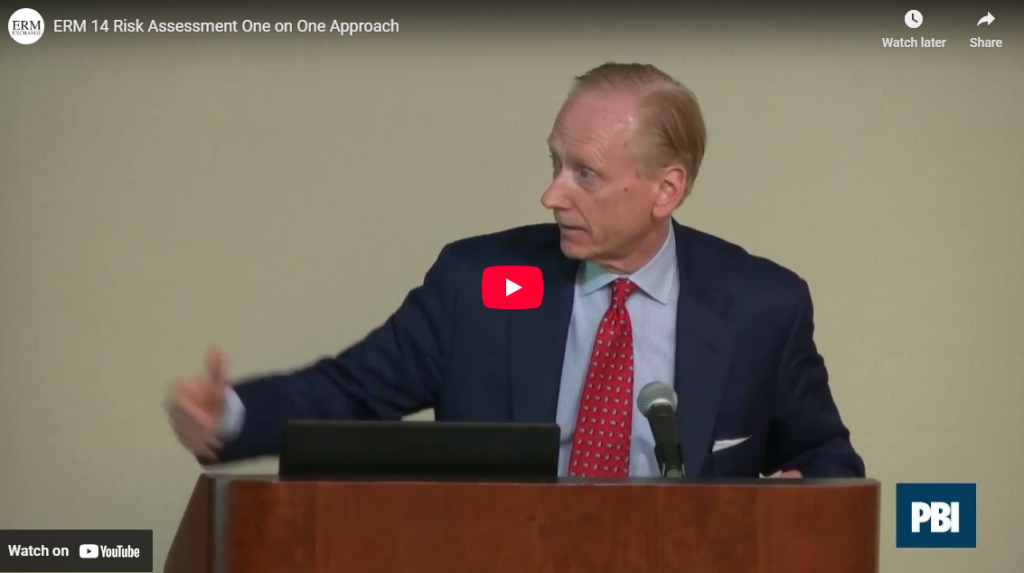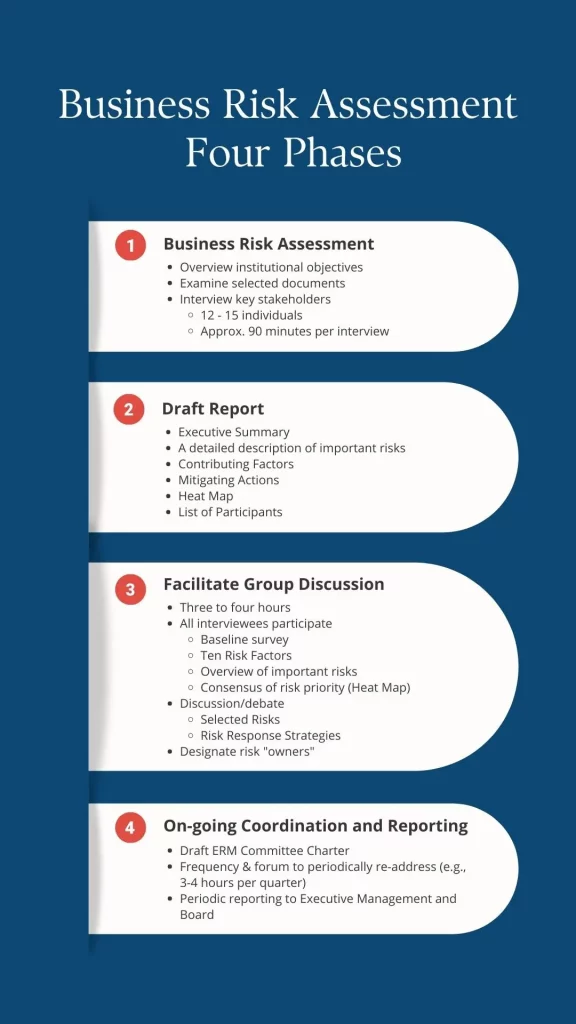We focus on identifying the most important risks to your business, not every small issue that could happen. Our strategic business risk assessment looks at what could go wrong and how likely it is. Then, we review what you’re already doing to handle those risks. These actions are called risk response strategies and tactics, and they can include many different steps to keep your business safe. Examples include:
Business Risk Assessment Services
- Using different types of insurance to protect your business
- Making sure staff have the right skills, or training them when needed
- Finding better ways to use technology
- Creating clear rules and steps for how things should be done
Business Risk Assessment Process with Expert Guidance
A business risk assessment is a process intended to help an enterprise FOCUS on “what’s important?” The process is broadly comprised of three activities:
- Spotting problems that could seriously hurt your business.
- Figuring out how big those problems might be, how likely they are to happen, and how quickly they could show up.
- Coming up with smart, simple ways to lower the chance of those problems happening—or make them less harmful if they do.
ERM Exchange’s business risk assessment looks at both numbers and expert opinions to understand how big a problem could get and how serious it might be. Then, it helps answer a key question: What can management do to lower the risk? It also considers how much time, effort, and money it might take. A good risk assessment doesn’t just find problems. It also points out missed chances, such as not upgrading old systems when you had the opportunity.
A Unique Risk Assessment Process
ERM Exchange’s methodology involves a step-by-step process designed to strengthen your organizational resilience:
- Understand Strategies and Objectives: Gain a thorough understanding of your organization’s plans and goals, exploring how they intertwine with strategic risks.
- Collect Information on Strategic Risk: Systematically gather intelligence on strategic risks, enabling a comprehensive understanding and proactive management of potential threats to long-term objectives and competitive advantage.
- Create Risk Management Plans for Action: Critically evaluated risk management plans establishes a robust framework for assessing business risks. This ensures resilience against uncertainties, ultimately leading to more predictable and successful outcomes.
- Share the Strategic Risk Assessment Framework and Plan: Once formulated, the strategic business risk assessment framework is presented to the organization. This facilitates the development and reinforcement of a robust risk culture within the company.
- Implement the Corporate Risk Assessment Plan: A collaboratively developed enterprise risk management action plan fosters a culture of continuous improvement. This strengthens the organization’s ability to achieve its mission consistently.
Elevate your business to new heights with our comprehensive risk assessment process. Our proven strategies not only mitigate risks but also lay the foundation for sustained success. Partner with ERM Exchange for a resilient and forward-thinking approach to managing uncertainties in today’s dynamic business landscape.
Choose ERM Exchange Business Risk Assessment Services
Business Risk Assessment starts by looking at the company’s plan and organization chart. It also includes evaluating reports about how the company is doing financially and operationally, along with other important information. Typically, the CEO sends a message to everyone involved to explain why the assessment is important and what is expected. Often, these assessments occur through one-on-one interviews.
Protecting each person’s anonymity is important. That’s why it helps to use someone outside the company to lead the process. When people aren’t worried about getting in trouble for being honest, they’re more likely to speak up. This leads to better, more honest feedback from everyone.
After hearing from everyone involved, we put together a report. This report lists the top 10 to 20 biggest risks to the business. Each risk includes details about what might cause it and what’s already being done to reduce it. We also place each risk on a heat map. This shows how likely it is to happen and how much damage it could cause. For some risks, we also look at how quickly they might appear. Then, everyone meets to talk about the risks. They review each one, share their opinions, and discuss if the current plans to handle them are strong enough. In the end, the goal is for everyone to agree on the most important risks. Each of these risks should connect clearly to the company’s big-picture goals.

The Goal Or Outcome Of Business Risk Assessment?
A greater level of clarity of each risk and the related response strategies.
Everyone should agree on the biggest risks and how to handle them. Each plan to deal with a risk should connect clearly to the company’s main goals.
A re-allocation of time, energy, and resources for the most important risk response strategies employed.
An “owner” or “champion” of each risk is identified.
Communication of emerging risks as well as changes to previously identified risks to senior executive management and the board on a periodic basis.
Continued understanding of important risks and modified risk response strategies.
How Do Our Cybersecurity Risk Assessment Benefit Organizations?
As part of our risk assessment services, you can choose to include a cybersecurity check from one of our trusted partners. This assessment looks at how well your current systems, staff, and processes protect your business from online threats. Cybersecurity threat and vulnerability risk assessments:
- Spot weak areas in your security landscape
- Understand how much damage a cyberattack could cause
- Put simple steps in place to reduce the risk
- Get quick alerts so you can act fast
It’s all about helping your business stay safe from hackers and data breaches.
ERM Exchange’s Risk Assessment Methodologies
ERM Exchange’s risk assessment methodologies will be based on what you need to achieve and the nature of your organization when creating your business risk management framework. Our business risk assessment helps companies of all sizes and types. It shows you the MOST important risks your business faces. This is the first step to building a strong plan to handle those risks. Knowing your risks early helps keep your business safe and prepared for problems.
FAQ about Business Risk Assessment
Business Risk Assessment is a process that involves identifying, analyzing, and evaluating potential risks that can affect a company’s operations, financial health, and overall success.
Risk Assessment process is crucial as it helps organizations proactively identify and manage risks, enabling them to make informed decisions and mitigate potential threats to achieving their business strategies.
The frequency of assessments often varies depending on the industry and how quickly things change within the specific business sector including the nature of the business, competition, technological influences, industry regulations, and customer preferences.
Challenges in executing an impactful Business Risk Assessment often include an unwillingness by senior leadership to dedicate time and energy into critically evaluating new and existing business strategies, and the risks to achieving those strategies. Many executive teams are “too busy” to stop and critically think about their situation. Another challenge is not including the next layer of management in the risk assessment process.


